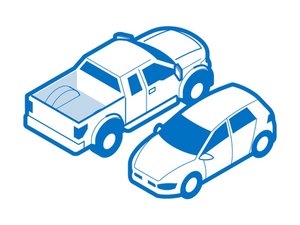Causes
Symptoms: Frequent intermittent knocking sounds when driving over bumps.
Diagnosis: Inspect the bushings for cracks and deformation.
- Make sure there's no play in the sway bar links.
- Use a crowbar to find a leverage spot on structural, load-bearing parts of the suspension.
- Rest the crowbar against these parts near the sway bar link and apply force on the link and the sway bar in different directions.
- If the components are defective, there will be noticeable play.
Solution: Over time, regardless of the type of sway bar link connection, the assembly loses structural rigidity, resulting in play and abnormal sounds. The bushings on the sway bars are not repairable and must be replaced.
Symptoms: Metallic thumps, rubber squeaking when driving on uneven roads or when turning the steering wheel.
Diagnosis:
- Remove the cover of the shock absorber mount, or if there is no cover, position the vehicle in a way so you can see the mount.
- Place a wheel chock on the floor and a board under the wheel you're working with.
- Step on the end of the board to apply pressure to the wheel and suspension components. Inspect the suspension mount as you move the board.
- A moving piston rod indicates a broken mounting seat or loose nut.
- An intermittent noise is a sign that the rubber damper is damaged.
Solution: New mounts should be installed.
Symptoms: Knocking and creaking sounds when maneuvering or driving over bumps, uneven tire wear, the car suddenly drifts in the wrong direction.
Diagnosis:
- Lock the steering wheel, jack up and firmly secure the vehicle.
- Grab the wheel and rock it back and forth horizontally and vertically.
- Check the ball joint for any damage.
- Free play accompanied by a knocking noise indicates a fault.
- Inspect the dust covers for damage.
- Moisture and dirt build-up are signs of a leaking part.
Solution: The ball joint is not fixable individually, so it is necessary to replace it with a full assembly.
Symptoms: Knocking sounds when driving over small bumps or on gravel, steering wheel vibration, uneven tire wear.
Diagnosis:
- Lock the steering wheel, jack up and firmly secure the vehicle.
- Rock the wheel back and forth horizontally.
- Check the tie rod for any damage.
- If there is play and a noise coming from the components, it means that the tie rod or tie rod end is broken.
Solution: Replace the tie rod assemblies.
Symptoms: Creaking sounds, uneven tire wear, poor steering, nose dive and squat, steering wheel vibrations.
Diagnosis:
- Park the car in a safe location where you can easily access the bushings of the vehicle.
- Test the elasticity of the bushings using a crowbar against the frame of the vehicle.
- Check condition of the rubber components by inspecting them visually. Cracks and discoloration indicate wear and these should be replaced.
Solution: Over time, the rubber parts lose their elasticity and deteriorate. These rubber-metal components can't be repaired; they should be replaced with new ones.
Sometimes the noise or knocking sound is caused by other surrounding parts that are faulty. You should also check the condition of the exhaust system mounts and fasteners, the spare wheel bolts for tightening, the condition of the suspension springs, and the brake pads and calipers for play.
If you have a grease gun, consider regreasing any zerk fittings on suspension parts during your inspections. While this may quiet some squeaking noises, it will not correct any knocking. As bushings lose their grease and vitality, metal parts will start to rub on each other and wear down. That's why a greasing and inspection service is recommended for every oil change.
Important! After repairing the car's suspension, make sure to realign the wheels. To do this, take your car to a shop that has an alignment machine and technicians.
